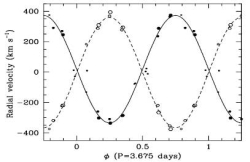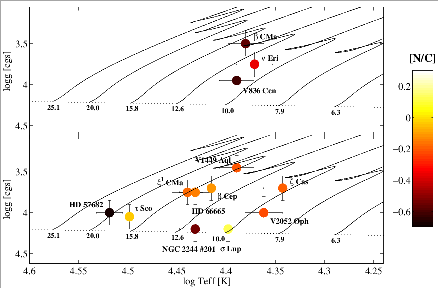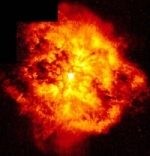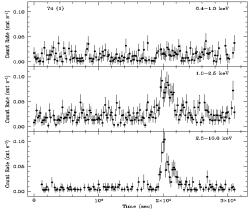- Home
- Research
- Massive Stars
- Wind Collisions
- High Energies
- Interstellar Medium
- Staff
- Outreach
- el TIGRE
Institut d'Astroph. et de Géoph.
Université de Liège
Quartier Agora
Allée du 6 août, 19c - Bât. B5c
B-4000 Liège (Sart-Tilman)
Belgique
Tel.: 04.366.97.16
Fax: 04.366.97.46
Massive Stars
- Introduction
- Physical parameters
- Wolf-Rayet stars
- Variables and/or peculiar stars
- Pre-main sequence (PMS) stars
Introduction

Massive stars are born with spectral type O. They have masses from a few tens to a hundred solar masses, surface temperatures from 30 000 to 150 000 Kelvins, and luminosities essentially larger than a few hundreds of thousands of solar luminosities. Because of such extreme luminosities, massive stars use their nuclear fuel much faster than lower mass stars and therefore their life-time does not exceed a few million years (compared to 10 billion years for the Sun).
The previous generations of massive stars (population III stars) have played a crucial role in the evolution of the Universe. These stars were indeed responsible for the re-ionization of the Universe at epochs corresponding to redshifts of 10 to 20! They probably also are the progenitors of gamma-ray bursts, the spectacular explosions that are detected almost every day by gamma-ray satellites. During those deep cosmos explosions, black holes were formed, which may be linked to the supermassive black holes that are found in the core of galaxies and of quasars.
The maximum of the energy emitted by massive stars is radiated in the ultraviolet domain, which makes them the most important ionizing sources of our Galaxy. Massive stars are then, in particular, responsible for the formation of emission nebulae. In addition, due to their intense radiation field, massive stars permanently eject important quantities of matter in the form of a very dense and energetic stellar wind: a typical O star ejects 5.1014 tons of matter every second in its surrounding space. This matter is accelerated by radiation pressure up to colossal speeds, of order 3000 km/sec! Such energetic stellar winds of course interact with their environment. First they shape their neighbourhood; next, in the case of double stars (also called binaries) consisting of two massive stars with stellar winds, the winds' collision produces a shock zone in which matter is heated to temperatures of several million Kelvins. This very hot matter generates an intense X-ray emission that can be studied theoretically, through numerical simulations, as well as via high energy observations. A fraction of the particles near the shock zone is accelerated to speeds close to that of light: such relativistic particles may generate gamma-ray emission that can be detected using gamma-ray space observatories, such as the ESA INTEGRAL satellite.
Because of their short life-times, massive stars significantly contribute to the chemical evolution of our Galaxy. Heavy elements synthesized inside a massive star are ejected in the interstellar medium either with the help of stellar winds, or through the supernova explosion that marks the end of the life of a massive star. Without these stars, the chemical composition of our solar system would be quite different from the one we know.
The study of the properties of massive stars is therefore essential for our understanding of the dynamical evolution of our Galaxy. This is why the GAPHE team devotes so much effort to a multi-wavelength observational study of these objects.
TopPhysical parameters

It is not easy to measure the size, the mass, the luminosity or the temperature of a star. One can obviously not put celestial objects on a scale or near a rule ! Mass is one of the physical parameters the most difficult to accurately measure. There is in fact only one way to do it: to study eclipsing spectroscopic binaries. Due to Kepler's laws, the analysis of the radial velocity variations (using the Doppler effect) yields a mass estimate, except for the effect of the inclination of the orbit! The latter uncertainly is lifted by the measurements of the luminosity variations, which enable also to determine the stellar radii, and subsequently the distance of the stellar system. The GAPHE has specialized in the detailed study of binary systems, in developing techniques leading to the knowledge of the periods and to the analysis of disentangled spectra. These techniques, when applied to clusters, also permit to constrain the global fraction of binaries which is a parameter deeply related to the stellar formation models, and which seems to vary from cluster to cluster according to the stellar density.

In addition, adjusting dedicated atmosphere models to observed spectra enables us to derive effective temperatures of stars, their gravities, the properties of their wind, as well as their chemical composition. These stellar abundances are important probes to detect mixing, which in turn may reflect the evolutionary stage of the star, an episode of mass-transfer in binaries, or the presence of peculiar processes (due to high rotation, magnetic fields,...). Massive stars, which are detectable from far away due to their brightness, are also good indicators of the metal abundance of the interstellar medium. Combined to the study of older stellar populations, this helps understanding the chemical evolution of our Galaxy.

In order to improve our knowledge of stellar physical parameters, one must accurately observe a large number of stars. This is the reason why GAPHE is getting more and more involved in the preparation of the European GAIA mission. As a Hipparcos successor, GAIA will measure during 5 years ten thousand times more objects than its predecessor, i.e. one billion Galactic stars! This ambitious mission is planned to produce astrometric, photometric and spectroscopic data which will enable to determine the distances (thus the absolute luminosity - a physical parameter which cannot be constrained in another way), the speeds (therefore the three-dimensional structure of our Galaxy) and the multiplicity of the stars. Among the stars to be observed, there should be of order 50 000 OB stars which are of particular interest to GAPHE: since several years the latter therefore actively contributes to the elaboration of the analysis software of GAIA.
Wolf-Rayet Stars

Named to honor French astronomers Charles Wolf and Georges Rayet who in 1867 discovered in Cygnus the first three stars of this type, the Wolf-Rayet stars (WR) are hot (effective temperature above 50 000 K) and luminous (luminosity of order 300 000 times that of the Sun) objects whose spectrum shows characteristics which make them easily identifiable. The spectrum indeed displays strong and broad emission lines of Helium, Nitrogen, Carbon and Oxygen while absorption lines are essentially absent. On the basis of the existence of these strong emission lines GAPHE has developed a series of filters enabling an easy detection of WR stars in outer galaxies, and has used them quite efficiently in recent years.
Wolf-Rayet stars appear among three sub-classes defined according to the presence of particular lines in their spectra: WN (lines of He & N), WC (He, C, O) and the more recent class of WO (highly ionized He, C, O). Compared to the classical solar abundances, the WNs thus show highly enhanced abundances of He and N, while those of C and O are reduced; in the WCs, to the contrary, He, C and O seem over-abundant while N is absent. H is present, and very weakly, in only few WNs: this lack of hydrogen in almost all WR stars is one of the main characteristics of this type of objects.
The non-solar chemical composition is qualitatively in agreement with the scenarios according to which in WR stars one observes the products of the nuclear reaction that took place in the stellar core (H-combustion via the CNO cycle in the WNs, He-combustion for the WCs). It is indeed generally agreed these days that WR stars represent an advanced stage in the evolution of massive stars, essentially of O-type. Several scenarios have been proposed in order to explain the surface appearance of the combustion products. For a long time the most popular one involved a mass transfer in close binary systems where the deeper layers of the initially most massive component become apparent. Other scenarios have however been suggested that do not require that the two components be close to each other, scenarios including mass loss and mixing processes of internal layers.

Despite there fairly reduced number (about 300 listed for our Galaxy), WR stars play a crucial role in the life and in the "ecology" of galaxies, for instance because of their considerable mass losses (about 10-5 solar mass per year). In addition to the kinetic energy outflow from the WR, which implies an input of material to the interstellar medium, what is interesting is that this material is made out of the products of nuclear fusion of hydrogen or helium. The WR winds thus significantly contribute to the chemical enrichment of the galactic medium.
Although interesting, the WR stars remain poorly known objects. For instance one important uncertainty concerns the fraction of binaries in the WR population, thus the importance of binarity in the evolution of WRs. GAPHE thus organizes extensive observing campaigns in order to detect the possible signature of binarity: at least two new binary systems have been discovered in such a way: WR 25 and WR20a.
Mass loss being an important property of WR stars, it is essential to try to determine it as accurately as possible: the GAPHE therefore studies in detail the variability of these objects, which is closely linked to the stellar winds. On the basis of long term observing runs, the group has searched for periodic luminosity variations that could be linked to structures in the stellar winds. On the other hand, the GAPHE researchers have performed multi-wavelength analyses of winds' collisions in WR systems, e.g. WR 22, WR20a, and WR21a that led to a better understanding of those systems.
Variables and/or peculiar stars
Several types of (hot) stars do exhibit variations, be them spectroscopic and/or photometric. They are of course of particular interest to GAPHE that has put together a set of techniques allowing the characterization of such variations (detection, period search, line profile evolution,...).
Such variations may be due to vibrations of the stellar surface and the observation of these "oscillations", combined with theoretical models, ought to reveal information on the physical parameters in the stellar cores. Only few massive stars are known to "vibrate": the GAPHE studies these rare cases, e.g. HD93521. The GAPHE has also participated to the analysis of a sample of O-stars observed with COROT: this constitutes a unique set of photometric observations covering the "micro-variations" of the targets over an interrupted period of several weeks.
The variations which are observed for massive stars may also be linked to the stellar winds. Indeed such winds are not perfectly homogeneous: there exist inhomogeneities in this unstable matter outflow, or even large scale structures having a variety of origins (magnetic confinement, winds' collisions,...). The GAPHE team is involved since a long time in the study of such types of variability, particularly for peculiar massive stars of type Of?p, Of, Oef, Oe,... This led us to caracterize the wind structures as well as to discover periodicities in some objects.
Among massive stars, some display peculiar spectral types, the Of-stars for example. The peculiarities of these stars can in fact probably be explained in two ways: either it is a type of objects going through a short evolutionary phase, thus rarely observed, or one is dealing with objects for which a physical parameter has an exceptional value (e.g. an intense magnetic field). The GAPHE deals with these objects, analyzes them in an attempt to understanding the origin of the peculiarities: this is performed through multi-wavelength observations, the search for variability, as well as the analysis of the environment(s) of these objects.
TopPMS Stars
Massive stars are not born alone, but in star clusters. Stellar formation is however far from being uniform in mass: less high-mass stars are formed than low-mass ones. For one star having a mass between 60 and 120 solar masses, there are 250 or so stars of 1-2 solar masses that are being formed! In addition, even if they are born at the same time, all stars of a given cluster are not at the same stage of their development. Since massive stars do evolve (very) rapidly, when one observes clusters containing such stars, one definitely observes also low-mass stars that are still in formation, i.e. pre-main sequence stars (PMS) - notably the T Tauri stars.

Our X-ray observations have thus lead us to observe PMS stars as well. This has indeed enabled to detect a few categories of PMS stars that could not have been identified through other techniques. These young stars exhibit X-ray emissions that are about a thousand times stronger than in adult stage, and they undergo eruptive stages with large X-ray bursts, whose observations constrain the coronal loop parameters. The same objects are also observed through H-alpha filters, since a strong emission at this wavelength usually indicates the existence of an accretion disk around the object.
Top


